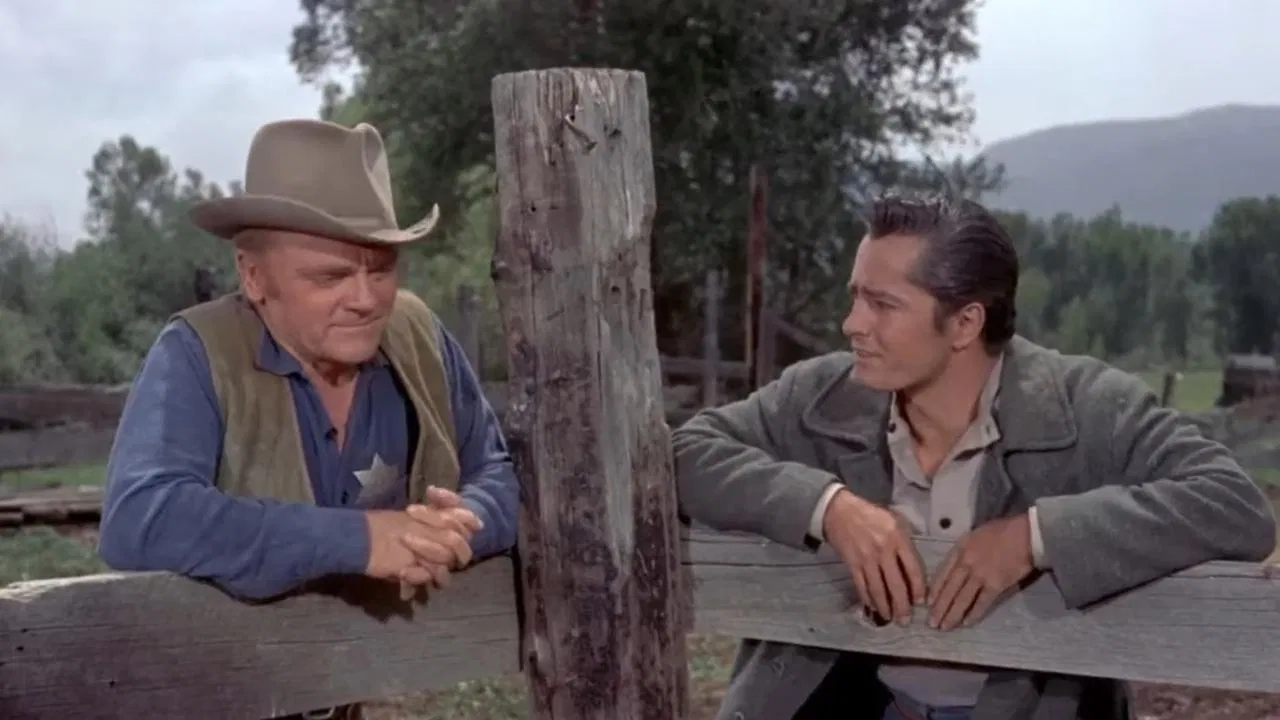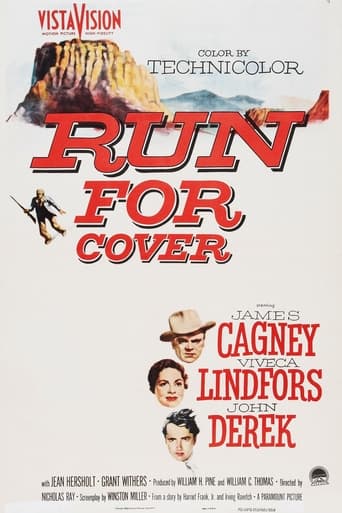ma-cortes
The story of a man apart who brought faith to a youth , love to a woman, justice to land . At the beginning takes place a trilling start when a man called Matt Dow (James Cagney) and his newcomer pal Davey Bishop (John Derek) are mistaken as two train robbers . Dow , who has a few secrets of his own , clears his name and ends up as the new sheriff and he appoints Davey as his deputy . Matt romances a foreign woman named Helga Swenson (Viveca Lindfors) and settles in to a peaceful existence only to find that the boy grows restive . The boy is crippled by a bullet provoking his fury and bitter slide into badness . This odd little film seems to be an offbeat Western , though also packs conventional scenes . It contains a superficially conventional script , drama , snappy scenes , action , thrills and shootouts . The characters are well constructed , the talks are fluid , concise and expressive and address special attention to gestures , glances and movements ; however , some excessive familiar touches cannot overcome a little boring screenplay . It lacks the baroque , bizarre excesses of Johnny Guitar , Nicholas Ray's first Western . At the end takes place the usual dispute between protagonists , James Cagney and John Derek , both of them share a mythical confrontation . Good acting by James Gagney as an ex-con becoming sheriff who tries to curb his own anger at the injustices he has suffered ; this is the second of three westerns that Cagney made , his first western was "The Oklahoma Kid" (1939) and his third and final one was "Tribute To A Bad Man" (1956). His embittered young as well as antagonistic companion was middlingly played by John Derek . The support cast is pretty good , being magnificent played by a group of splendid secondaries such as Ray Teal , Ernest Borgnine , Denver Pyle , Grant Whiters , Jack Lambert and final film of Jean Hersholt. Colorful cinematography by Daniel L Fapp , though rereleased in black-and-white and an alright remastering being necessary . Producers acknowledge with thanks the cooperation of the department of Interior National Park Service for the scenes photographed in the Aztec ruins , National Monument Aztec , New Mexico .The motion picture was professionally directed by Nicholas Ray , though some moments results to be tiring and slow-moving . Nicholas has a sensitive handling of actors and provides an exact compositional sense . Ray is a classic director , his films deal with a deep description of civilized societies , he believes that corruption is an essential part of it , that society punishes sincerity , innocence and love, vengeance and greed determine the behavior of people. Other ordinary themes is the gulf between generations : the older and the youngest . Nicholas Ray is concerned adolescence and youth, to which he devotes a later work , just like "Rebel without a Cause", 1955 . He denounces violence in American society and shows the rough face of frustration and sexual repression . As the great and stylish filmmaker Nicholas Ray working at the peak of his powers in Knock on Any Door with Humphrey Bogart and again John Derek . Other successes of this master filmmaker shooting all kinds of genres are the followings : Wartime such as Flying Leathernecks , Bitter victory , Noir : Party Girl , Wetern : Johnny Guitar , The True Story of Jesse James , Adventure : The Savage Innocents , Wind Across the Everglades and the epics : 55 Days at Peking ,Kings of Kings .
alexandre michel liberman (tmwest)
In April, 30, 1955 Bosley Crowther in the New York Times compared this film unfavorably with High Noon stating "there is little in "Run for Cover" to compare with the lean, leathery pictorial poetry and the stunning social comment of "High Noon." For this William Pine-William Thomas Western, directed by Nicholas Ray, is sheer horse opera without freshness or feeling and with practically nothing to say." I totally disagree with Crowther and his point of view is just a sample of how this western was unappreciated when originally released. If in High Noon there is a social comment, in "Run For Cover" there is a great psychological study of how individuals react when life gives them a hard time. Just the words Cagney beautifully says:" You think you got a raw deal? It comes with the ticket, nobody guarantees you a free ride, the only difference is most people don't run for cover, they keep right on going picking up the pieces the best way they can" are worth the film. This is a colorful, well directed western with good action scenes, entertaining from beginning to end. Don't miss it!!
Martin Teller
Not a terribly deep western, but a satisfying one that makes some decent social commentary. Unfortunately, this is a VistaVision film, but the copy I saw was in Academy ratio. So I can't comment too much on the cinematography... I'll just say I didn't see anything there that hinted at greatness. I'm not the world's biggest Cagney fan, however I liked his performance here as a man of upstanding integrity. This might also be the film's biggest weakness, the protagonist is a little too perfect. But he's a hero that's enjoyable to watch interact with those around him, especially those of lesser character. The supporting roles by John Derek and Viveca Lindfors are unremarkable but solid. The movie keeps things moving at a steady pace, maybe too steady but quite watchable. There are a couple of interesting surprises as well. There are certainly better westerns out there, but you could do a whole lot worse.
bkoganbing
Run For Cover was the second of three westerns that James Cagney made and in my mind it is easily the best of them. The Cagney of Yorkville is left way behind in a way he wasn't in The Oklahoma Kid.Cagney is a recently pardoned prisoner who spent six years in jail for a crime he didn't commit. He meets up with young John Derek on the trail and the two hit it off. But unfortunately they are mistaken by some panicky railroad employees as members of a local gang and get a sack of money thrown down at them. Then its further compounded by a trigger happy sheriff played by Roy Teal who shoots them both down, seriously wounding Derek.Derek is bitter as the result of permanent injuries to his leg, but the townspeople warm up to Cagney and replace Teal with him as sheriff. But Derek isn't up to the job of deputy in a few senses of the word.Derek did his mending on the farm of Jean Hersholt where there's a lovely Swedish farmer's daughter in Viveca Lindfors. She and Cagney hit it off quite well. In fact this was the farewell screen role for Jean Hersholt.Grant Withers makes a fine sinister outlaw leader with Ernest Borgnine as a very sly second in command. Their robbery scheme sets up the whole inevitable climax between Cagney and Derek.Cagney was a far better westerner in Run For Cover than in any of his other two westerns. I like very much the way director Nicholas Ray built up his two leads and there's good development of the secondary characters, always the mark of a good film.

